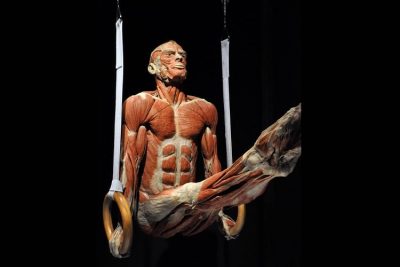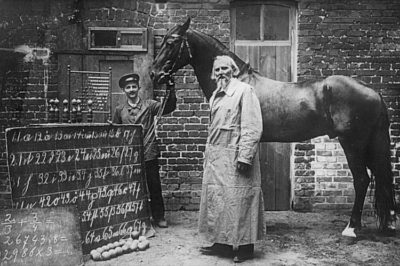The Peculiar Tale of Hans Langseth and his Long Beard
Share

A young girl about to attempt skipping from Hans Langseth’s Beard. (Wellcome Images / Flickr)
Born on July 14, 1846 in Norway, Hans Nilsen Langseth was the fourth of the five children born to Nils Olsen Langseth and Marthe Gulbrandsen Overholtet. He followed the footsteps of his three brothers and moved to the United States and settled in Kensett, Iowa, with his wife Anne. He raised a family of six children, all born on the American soil and worked as a farmer.
Growing the world’s longest beard
The most stunning feature of Hans was his beard, whose length set a world record. Langseth began nurturing his beard since the age of 19, as approximated by a physical and forensic anthropologist, Dr. David Hunt. He started to grow his beard in order to participate in a local beard-growing competition and continued to do so even after it. As a fact, beard hair can only grow four to five feet before dying and ceasing to grow.
But Langseth did not have that issue as he used to entangle the dead hair together to elongate his beard – making it stronger in the process, similar to the styling that can be observed in this modern era’s dreadlocks. His effort did not go in vain, as his beard continued growing and it still holds the world record for the longest beard on a male with an astonishing length of 17 feet 6 inches or 5.33 meters.
A notable feature of his beard, as remarked by Dr. Hunt, was that the beard represented a timeline of his life. The brown parts of his beard indicated his youthful hair colour and lifestyle, whereas the yellowed parts represent his older years. He lost his wife six months after his youngest child was born when he was 40-years-old. Langseth, then, moved with his children to Glyndon, Minnesota and eventually to Barney, North Dakota.
Fame and after death
In his older years, Langseth travelled around the country as a part of an exhibition showcasing his beard. He quit when he reportedly got tired of people pulling his beard to verify its authenticity. Langseth’s beard was declared to be the longest in the country in 1922 at a celebration, culminating a search conducted by a group known as the Whiskerinos.
He passed away in North Dakota in 1927, where he was buried before an eventual move to Kensett, beside his wife’s grave. His final wish was to have his beard cut off and stored. His son honoured his father’s wish but left a 12-inch beard on his dead body behind. After some decades, his other son Russell donated the beard to the Smithsonian, where it was displayed as a part of the museum’s physical anthropology exhibit from 1967 to 1991.
It was later moved into the archives, only to resurface whenever one of the descendants of Langseth wishes to examine their ancestor’s record-holding beard. According to Dr. Hunt, the Smithsonian kept Langseth’s beard for research purposes, like many other artefacts, analyzing them to find out about the life of a person, their dietary preferences or their illnesses. But his beard did not undergo such tests.

Hans Langseth and his long beard. (Jorgenson, Nils C. / Wikimedia Commons)
Confusion between Hans Langseth and Hans Steininger
However, the unclear documentation of his beard and his life did not prevent the confusion surrounding his identity. Hans Langseth is often confused with Hans Steininger, who was the mayor of a little town known as Braunau am Inn, Austria, around 1567. The town became popular later as the birthplace of Adolf Hitler.
But, the people of the town would rather consider Steininger be the famous person from their town since he, too, had a long beard – a four and a half-foot one at that. Steininger was a beloved Mayor and was well-known for his beard. It dangled from his face in one long tendril, complete with a forked tip at the end. Steininger would roll his beard up and put it in a leather pouch. The leather pouch was then neatly tucked into a pocket.
His story took a turn for the bizarre on one fateful day. On September 28, 1567, a fire broke out in the town Braunau am Inn. As it was the sixteenth century, the fire resistance measures weren’t as thorough as they are on this day. To quell the rising panic in the crowd, Steininger, being the person in command of the town, arrived at the spot himself.
During his efforts to control the situation, his beard came loose from the pocket and the pouch. He did not try to make any attempt to roll the beard back up and pushed it out of the way, making it dangle freely. That minor mistake had cost him his life. He stepped on his own beard and tumbled down from the top of a flight of stairs. The incident broke his neck instantly, resulting in his death.
However, there were conflicting reports regarding this story, as some claimed that he perished in the fire rather than tripping over his own beard. In either case, the cause of his death was not natural, as opposed to Hans Langseth.
The people of Braunau am Inn erected a monument memorizing their fallen mayor and collected his beard before he was buried and preserved it in the town’s historical museum. They took all steps necessary to ensure that his efforts to grow the beard did not go in vain. It has been preserved for more than 450 years taking help of chemical preservation techniques.
His beard attracts curious visitors to this little town in Austria. The confusion began when some individual started claiming Hans Langseth’s pictures as Hans Steininger, committing a grave error in the process. The first camera was not invented until much later than the mid-sixteenth century, eliminating the possibility of the existence of a photograph of Hans Steininger, the one who tripped on his own beard and died.
The photo, widely in circulation claiming to be that of Steininger, belongs to Hans Langseth, which was taken when he was 66-years-old.
Enjoyed this article? Also, check out “Martin Laurello: The Astounding ‘Human Owl’ Who Could Turn His Head Around By 180 Degrees“.
Recommended Visit:
Smithsonian Institution | Washington, D.C., United States of America
Fact Analysis:
STSTW Media strives to deliver accurate information through careful research. However, things can go wrong. If you find the above article inaccurate or biased, please let us know at [email protected]













